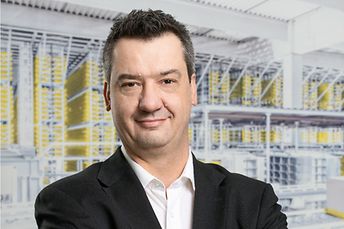

“Sustainable IT is more than just an energy-saving server. It involves intelligent and useful data management, such as in traffic, energy or logistics.”
(Matthias Horx, futurologist)
Intralogistics systems are becoming larger and larger and increasingly complex. Today’s computing power of a modern warehouse IT infrastructure is breaking new ground in terms of size and complexity, thus reaching dimensions that would have been unimaginable just a couple of years ago.
Today, as in the past, the basic principle of storage remains the highest possible efficiency. Only efficient storage systems allow companies to maintain a competitive edge and to fulfill high customer demands. But how does efficiency define itself in today’s work environment of the 21st century? The modern concept of efficiency goes beyond economic parameters – towards an ecological, holistic and thus sustainable approach.
The optimization of economic and ecological balances always depends on current possibilities and future progress. Therefore, the question of the extent of possible increases in efficiency and effectiveness may never be definitely answered. SSI SCHAEFER and its 11,000 employees are aware of the consequential long-term responsibility to deal with these questions and challenges. SSI SCHAEFER stands for state-of-the-art software management and improvement of energy efficiency throughout the entire process.
IT industries play an interesting role when it comes to sustainability. On the one hand, they consume a lot of energy and generate large amounts of excess heat, not to mention e-waste. But at the same time, these industries hold the key to solving several environmental issues with their software solutions. The use of software has multiplied in the past decades. The enormous increase of software-driven possibilities is illustrated by the growth of programmed code lines (total) over the decades. [1]
Today, a standard compact car requires about 250 times more programming lines than a space shuttle needed to fly into space about 30 years ago. This increase in the software share goes hand in hand with a functional extension as well as the improvement in efficiency criteria. Without a state-of-the-art software management, it would be impossible to achieve the EURO 6 standards for motor vehicles. The same applies to warehousing as it requires a perfect interaction between hardware and intelligent software, similar as it is the case for cars and planes. The role of software has had similar quantum leaps over the past decades.
Software-optimized storage strategies are applied to optimize the realization of logistical tasks. Automatic high-bay warehouses, shuttle systems or miniload cranes, provide the corresponding strategic solutions for the following requirements: storage, selection of loading unit, retrieval, relocation, sequencing and command cycles. Optimization criteria typically include the system performance or energy requirements. To increase the efficiency of storage criteria, SSI SCHAEFER opts for the in-house logistics software WAMAS® or the SAP-based solution with a special algorithm. Due to the software the strategy can be adapted to situation-specific parameters. It results in shorter walking distances and higher performance, which provides enormous savings potential.
It can be more sustainable to process orders together rather than carrying out each order separately. This way, it is possible to save packaging material, printouts etc. However, this also means that the requirements are cumulated at the time of completion. Modern warehouse management software adjusts to peak times and supports the savings potential to reduce the costs for order processing.
With our vertical storage lift SSI LOGIMAT® various small parts can be picked in a particularly fast manner, for instance by assembling kits. By means of the software WAMAS® LOGIMAT with new special algorithmic approaches, an optimized grouping of items can be achieved and thus the overall system performance can be immediately increased. The energetic return on investment for practice-related capacity and operation in two shifts amounts to less than four weeks. Projected over a year, two vertical storage lifts result in overall savings of kinetic energy equivalent to the annual requirements of a one-person household, which is achieved by the possible reduction of tray changes.[2]
From an economic point of view, an automated system does not require the same performance at off-peak times as at peak times - a distinction must be made here: devices can be reconfigured and thus reduced in terms of their acceleration and maximum speed values. A state-of-the-art warehouse management software such as WAMAS® automatically recognizes these off-peak periods and reduces the energy consumption in order to take account of the ecological conditions of the future.
Integrated transport management starts with an efficient packing and loading of goods. Due to software-supported simulations (Schaefer Packing Pattern Generator SPPG), it is possible to determine the optimum degree of space utilization of the loading units. This facilitates
an optimum use of pallets,
a reduction of shipping pallets
a reduction of packing material
By means of a special transport management software such as WAMAS® and SAP TM, it is possible to combine consignments and to carry out software-based tour planning and route optimization. This results in an optimum use of cargo in the trucks and thus a massive reduction of energy and transport costs.
Sustainability in warehouse management also means flexible adaptation to external conditions. State-of-the-art tour planning software solutions must be able to modify the departure times and delivery sequences daily, based on intelligent traffic prognosis. This, for instance, helps to avoid that trucks are stuck in traffic. Today’s software solutions can easily deal with changing staging times and modified allocations of orders to tours and sequences. By doing so, the warehouse management software adapts to the business that is changing every day, thus reducing the ecological footprint.
Basically, storage systems are designed for the staging of goods for production and/or shipment. Returns, i.e. goods, which are sent back, run exactly in the opposite direction of the actual material flow. Frequently, this process is so costly that it exceeds the higher value of goods and it is therefore most cost-effective to destroy the returned goods. [3] This ecologically and socially highly questionable decision can be avoided with a state-of-the-art warehouse management software. Modern systems such as the logistics software WAMAS® facilitate the transparent tracking of returns and reduce the additional costs for the reintegration of already shipped goods into the staging process.
Predictive maintenance is one of the most prominent use cases of Industry 4.0 and promises to conserve resources by avoiding unnecessary, premature replacements of components and preventing failures at the same time. This way, the service life of machines and systems can be extended, and investment costs can be reduced. Moreover, damages can be identified before they occur, and repairs can be planned and carried out in a better way.
With retrofit services for warehouse modernization, SSI SCHAEFER is upgrading systems and extending their service life. IT modernization, for example, involves replacements of server and client hardware, updates of operating systems or databases, modifications/extensions of current IT processes or a release change or migration (if required). Extensions or IT modernizations integrate new material flows perfectly. Your benefits include increased productivity, optimized flows of goods and energy savings.
[1] Space Shuttle 1981: 400,000 programmed code lines; Golf 8 2018: 100,000,000 (estimated) programmed code lines; Source: informationisbeautiful.net/visualizations/million-lines-of-code/
[2] This savings potential varies depending on item range, application, SSI LOGIMAT design and order structure. The data only serve to illustrate the savings potential.
[3] According to information, Amazon destroys goods worth more than 20,000 euros every day.
Author: Markus Klug, Data Science & Simulation
